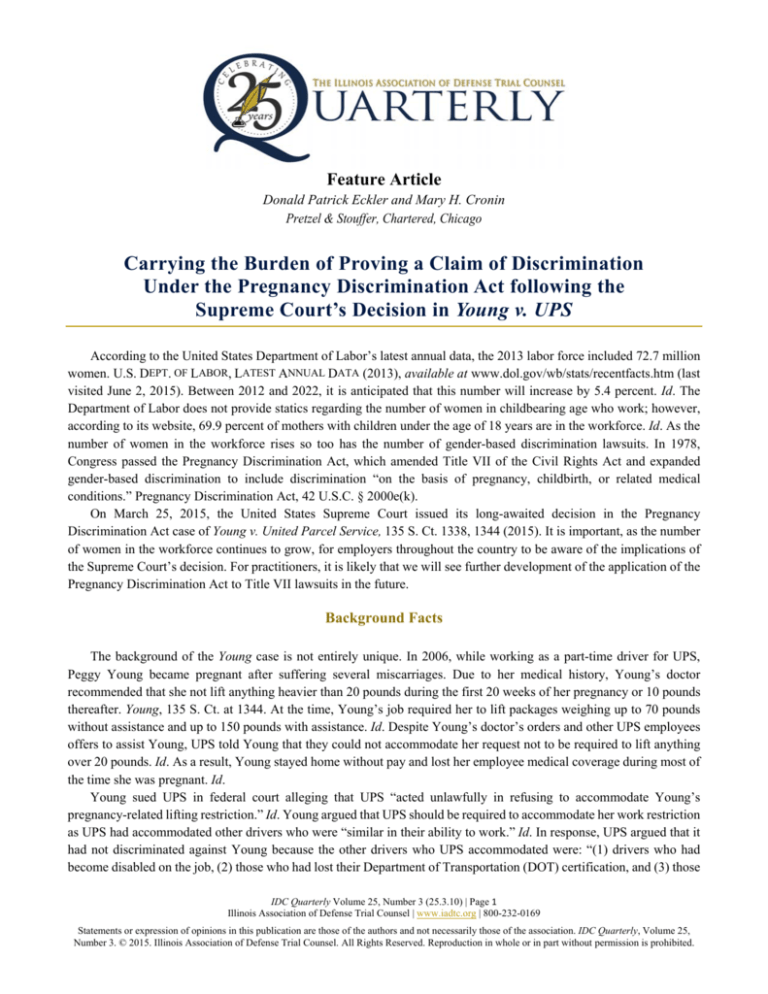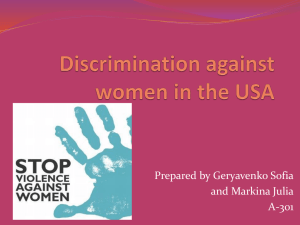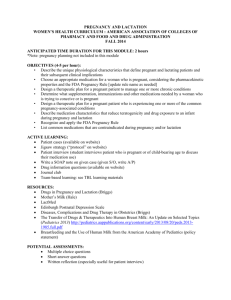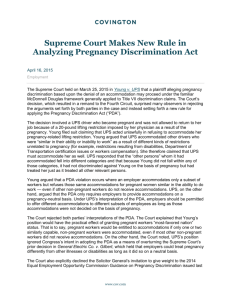
Feature Article
Donald Patrick Eckler and Mary H. Cronin
Pretzel & Stouffer, Chartered, Chicago
Carrying the Burden of Proving a Claim of Discrimination
Under the Pregnancy Discrimination Act following the
Supreme Court’s Decision in Young v. UPS
According to the United States Department of Labor’s latest annual data, the 2013 labor force included 72.7 million
women. U.S. DEPT. OF LABOR, LATEST ANNUAL DATA (2013), available at www.dol.gov/wb/stats/recentfacts.htm (last
visited June 2, 2015). Between 2012 and 2022, it is anticipated that this number will increase by 5.4 percent. Id. The
Department of Labor does not provide statics regarding the number of women in childbearing age who work; however,
according to its website, 69.9 percent of mothers with children under the age of 18 years are in the workforce. Id. As the
number of women in the workforce rises so too has the number of gender-based discrimination lawsuits. In 1978,
Congress passed the Pregnancy Discrimination Act, which amended Title VII of the Civil Rights Act and expanded
gender-based discrimination to include discrimination “on the basis of pregnancy, childbirth, or related medical
conditions.” Pregnancy Discrimination Act, 42 U.S.C. § 2000e(k).
On March 25, 2015, the United States Supreme Court issued its long-awaited decision in the Pregnancy
Discrimination Act case of Young v. United Parcel Service, 135 S. Ct. 1338, 1344 (2015). It is important, as the number
of women in the workforce continues to grow, for employers throughout the country to be aware of the implications of
the Supreme Court’s decision. For practitioners, it is likely that we will see further development of the application of the
Pregnancy Discrimination Act to Title VII lawsuits in the future.
Background Facts
The background of the Young case is not entirely unique. In 2006, while working as a part-time driver for UPS,
Peggy Young became pregnant after suffering several miscarriages. Due to her medical history, Young’s doctor
recommended that she not lift anything heavier than 20 pounds during the first 20 weeks of her pregnancy or 10 pounds
thereafter. Young, 135 S. Ct. at 1344. At the time, Young’s job required her to lift packages weighing up to 70 pounds
without assistance and up to 150 pounds with assistance. Id. Despite Young’s doctor’s orders and other UPS employees
offers to assist Young, UPS told Young that they could not accommodate her request not to be required to lift anything
over 20 pounds. Id. As a result, Young stayed home without pay and lost her employee medical coverage during most of
the time she was pregnant. Id.
Young sued UPS in federal court alleging that UPS “acted unlawfully in refusing to accommodate Young’s
pregnancy-related lifting restriction.” Id. Young argued that UPS should be required to accommodate her work restriction
as UPS had accommodated other drivers who were “similar in their ability to work.” Id. In response, UPS argued that it
had not discriminated against Young because the other drivers who UPS accommodated were: “(1) drivers who had
become disabled on the job, (2) those who had lost their Department of Transportation (DOT) certification, and (3) those
IDC Quarterly Volume 25, Number 3 (25.3.10) | Page 1
Illinois Association of Defense Trial Counsel | www.iadtc.org | 800-232-0169
Statements or expression of opinions in this publication are those of the authors and not necessarily those of the association. IDC Quarterly, Volume 25,
Number 3. © 2015. Illinois Association of Defense Trial Counsel. All Rights Reserved. Reproduction in whole or in part without permission is prohibited.
who suffered from a disability covered by the Americans with Disabilities Act of 1990 (ADA).” Id. Therefore, UPS
treated Young “just as it treated all ‘other’ relevant ‘persons,’ not on the basis of Young’s pregnancy.” Id. Notably, the
Americans with Disabilities Act was amended subsequent to Young’s pregnancy in 2008 specifying that “‘physical or
mental impairment[s] that substantially limi[t]’ an individual’s ability to lift, stand, or bend are ADA-covered
disabilities.” Id. at 1348.
The Majority’s Analysis
Under Title VII of the Civil Rights Act, an employer may not “discriminate against any individual with respect to .
. . terms, conditions, or privileges of employment, because of such individual’s . . . sex.” Id. (citing 78 Stat. 253, 42
U.S.C. § 2000e-2(a)(1)). The Pregnancy Discrimination Act extended the prohibition of discrimination on the basis of
sex to include “because of or on the basis of pregnancy, childbirth, or related medical conditions.” Young, 135 S. Ct. at
1344-45 (citing 42 U.S.C. §2000e(k)). The Supreme Court analyzed Young’s “disparate-treatment” claim that UPS
intentionally treated Young less favorably than employees with Young’s qualifications but outside Young’s protected
class. Id. The Supreme Court noted that “[l]iability in a disparate-treatment case depends on whether the protected trait
actually motivated the employer’s decision.” Id. The key analysis of the Supreme Court’s opinion was the second clause
of the Pregnancy Discrimination Act, which provides:
women affected by pregnancy, childbirth, or related medical conditions shall be treated the same for all
employment-related purposes . . . as other persons not so affected but similar in their ability or inability to work
...
Id. at 1345. The language within this second clause of the Act that required the most analysis is the portion that states “as
other persons not so affected but similar in their ability or inability to work.” Id. at 1348-49 (citing 42 U.S.C. § 2000e(k))
(emphasis added by the Court). It is unclear whom Congress included among these “other persons.” Id. The Supreme
Court, in reliance on petitioner’s reply brief, stated that the analysis of this clause boils down to whether the Act requires
“giving ‘the same accommodations to an employee with a pregnancy-related work limitation as it would give that
employee if her work limitation stemmed from a different cause but had a similar effect on her inability to work.’” Id. at
1349 (citing the Petitioner’s Reply Brief) (emphasis in original).
The petitioner and the United States argued that the second clause “requires an employer to provide the same
accommodations to work-place disabilities caused by pregnancy that it provides to workplace disabilities that have other
causes but have a similar effect on the ability to work.” Id. at 1349. The Supreme Court found that the respondent
minimized the implications of the second clause taking the position that the language was intended to merely “define sex
discrimination to include pregnancy discrimination.” Id. This interpretation would require the courts in determining
whether an employer violated Title VII to analyze “the accommodations an employer provides to pregnant women with
the accommodations it provides to others within a facially neutral category.” Id. (citing dissent of Scalia, J.) (emphasis
in original). The majority of the Supreme Court declined to accept either interpretation. Id.
The Supreme Court found the petitioner’s literal interpretation too broad. Id. Under the petitioner’s approach, if “an
employer accommodates only a subset of workers with disabling conditions,” then “pregnant workers who are similar in
the ability to work [must] receive the same treatment even if still other non-pregnant workers do not receive
IDC Quarterly Volume 25, Number 3 (25.3.10) | Page 2
Illinois Association of Defense Trial Counsel | www.iadtc.org | 800-232-0169
Statements or expression of opinions in this publication are those of the authors and not necessarily those of the association. IDC Quarterly, Volume 25,
Number 3. © 2015. Illinois Association of Defense Trial Counsel. All Rights Reserved. Reproduction in whole or in part without permission is prohibited.
accommodations.” Id. Petitioner argues that respondent violated the statute because pregnant workers and non-pregnant
workers were not treated the same. Id. The Supreme Court found this approach to be problematic because it requires
employers to give all pregnant workers the same accommodations that the employer may provide even one or two workers
irrespective of any factor considered in providing an accommodation for a non-pregnant worker, such as the worker’s
age or the nature of their job. Id.
Justice Breyer, who drafted the majority opinion, agreed with the respondent that petitioner’s approach would grant
pregnant workers an unconditional “most-favored-nation” status. Id. at 1349-50. The Supreme Court noted that the
second clause does not provide that an employer must treat pregnant workers as “any other persons.” Id. at 1350
(emphasis in original). In addition, disparate-treatment claims generally may be overcome by proof that an employer’s
policy may have an unfavorable affect on a protected class, but an employer has “a legitimate, non-discriminatory, nonpretextual reason” for the policy. Id. The history of the Act does not indicate that Congress intended any deviation from
this approach generally taken in disparate treatment cases. Id.
The Supreme Court stated that the Equal Employment Opportunity Commission (EEOC) issued guidance prior to
and following Congress passing the Pregnancy Discrimination Act by stating that a disability caused by or contributed
to by pregnancy is considered a temporary disability and should be treated the same in terms of benefits and privileges
as they are applied to other temporary disabilities. Id. at 1351. The EEOC also stated that “[i]f other employees
temporarily unable to lift are relieved of these functions, pregnant employees also unable to lift must be temporarily
relieved of the function.” Id. The Supreme Court found that the EEOC’s guidance did not clarify the ambiguous language
of “other persons” set forth in the second clause of the Act. Id. The Supreme Court wrangled with the notion that while
it is clear that pregnancy related disabilities should be treated the same as non-pregnancy related disabilities, this does
not clarify what an employer is required to do when it does not treat all non-pregnancy related disabilities the same. Id.
The majority discussed another landmark gender-based discrimination case, General Electric Company v. Gilbert.
Id. at 1353 (citing General Electric Co. v. Gilbert, 429 U.S. 125 (1976)). In Gilbert, the Supreme Court evaluated whether
a company policy that gave “‘nonoccupational sickness and accident benefits to all employees’ without providing
‘disability-benefit payments for any absence due to pregnancy.’” Young, 135 S. Ct. at 1353 (citing Gilbert, 429 U.S. 125
at 128-29). In Gilbert, the Supreme Court held that this policy did not constitute sexual discrimination under Title VII
because the policy distinguished between pregnant workers versus non-pregnant workers, not men versus women. Young,
135 S. Ct. at 1353. The Court found that while pregnancy was “confined to women,” it was not “comparable in all other
respects to [the] diseases or disabilities’ that the plan covered.” Id. The Court also did not consider pregnancy a disease
or a result of an accident. Id. In addition, the Court did not believe that the purpose for the distinction was gender-based
discrimination. Id.
Scalia’s Dissent
In the dissenting opinion written by Justice Scalia, and joined by Justices Kennedy and Thomas, he argued that he
was advocating adoption of the position set forth in Gilbert, acknowledging that the Pregnancy Discrimination Act
overturned the Gilbert decision. Id. at 1364. However, Justice Scalia argued that the plan in Gilbert is different than the
alleged discrimination in this case because the Gilbert plan specifically singled out pregnancy for disfavor. Id. Justice
Scalia stated that the employment plan at issue in Gilbert was not a neutral plan, but rather “place[d]...pregnancy in a
IDC Quarterly Volume 25, Number 3 (25.3.10) | Page 3
Illinois Association of Defense Trial Counsel | www.iadtc.org | 800-232-0169
Statements or expression of opinions in this publication are those of the authors and not necessarily those of the association. IDC Quarterly, Volume 25,
Number 3. © 2015. Illinois Association of Defense Trial Counsel. All Rights Reserved. Reproduction in whole or in part without permission is prohibited.
class by itself.” Id. The plan specifically denied coverage for sicknesses on account of pregnancy but not on account of
other conditions such as “sports injuries” or “elective cosmetic surgeries.” Id.
Justice Scalia stated that “[t]he most natural way to understand the same-treatment clause is that an employer may
not distinguish between pregnant women and others of similar ability and inability because of pregnancy.” Id. at 1362
(emphasis in original). Justice Scalia explained that “[i]f a pregnant woman is denied an accommodation under a policy
that does not discriminate against pregnancy, she has been ‘treated the same’ as everyone else.” Id. Employing a satirical
approach, Justice Scalia claimed that the majority used a wand to reach the result that it desired result without offering a
sufficient explanation for the result. Id. at 1364. Justice Scalia argued that the words in the second clause “shall be treated
the same” does not mean that the courts have to balance “the significance of the burden on pregnant workers against the
strength of the employer’s justifications for the policy.” Id.
Justice Scalia also criticized the majority’s opinion for failing to distinguish disparate treatment claims (one in which
an employment policy is based upon a “discriminatory motive”) from a discriminatory impact case (where the effect of
a policy harms one group more than another without justification). Id. at 1365. The majority noted early in its opinion
that petitioner had not brought a disparate impact claim. Id. at 1345. Justice Scalia argued that the majority’s decision
allows a pregnant woman to establish disparate treatment by showing that the effects of the employers’ policy fall more
harshly on pregnant women than others and are unjustified. Justice Scalia found this result problematic because these
two different types of claims come with different standards of liability, different defenses, and different remedies. Id. at
1365. For instance, a plaintiff can be awarded compensatory and punitive damages in a disparate treatment case, but only
equitable relief in a disparate impact case. Id.
The Supreme Court majority found that the dissenting opinion, as well as the position espoused by UPS relying on
the Gilbert decision, failed to acknowledge that the purpose of the Pregnancy Discrimination Act was to overturn the
Court’s ruling in Gilbert as well as its rationale. Id. at 1353.
Conclusion
In establishing the burden of proof in a Pregnancy Discrimination Act case, the Supreme Court applied the framework
from the discriminatory hiring case of McDonnell Douglas Corp. v. Green, 411 U.S. 792 (1973). Id. at 1353-54. The
Supreme Court held that the elements of a cause of action under the second clause of the Pregnancy Discrimination Act
include: (1) plaintiff belongs to a protected class; (2) plaintiff sought accommodation; (3) the employer did not
accommodate plaintiff; and (4) the employer accommodated others “similarly in their ability or inability to work.” Id. at
1354. If plaintiff makes out a prima facie case, then the burden of proof shifts to the defendant to show that its refusal to
accommodate plaintiff was based upon “legitimate, non-discriminatory” reasons. Id. These reasons cannot include “that
it was more expensive or less convenient to add pregnant women” to add the pregnant women to the group of people that
the employer accommodates. Id.
The analysis does not end here. If a defendant offers a “legitimate, non-discriminatory reasons,” plaintiff avoids
summary judgment by showing that “the employers ‘legitimate, non-discriminatory’ reasons are not sufficiently strong to
justify the burden, but rather—when considered along with the burden imposed—give[s] rise to an inference of intentional
discrimination.” Id.
The Supreme Court noted that a plaintiff could argue that a genuine issue of material fact exists when the employer
accommodates a large portion of non-pregnant workers, but not a large percentage of non-pregnant workers. Id. at 1354IDC Quarterly Volume 25, Number 3 (25.3.10) | Page 4
Illinois Association of Defense Trial Counsel | www.iadtc.org | 800-232-0169
Statements or expression of opinions in this publication are those of the authors and not necessarily those of the association. IDC Quarterly, Volume 25,
Number 3. © 2015. Illinois Association of Defense Trial Counsel. All Rights Reserved. Reproduction in whole or in part without permission is prohibited.
55. Young claimed that she could prove that UPS accommodated most non-pregnant employees with lifting restrictions
and categorically denied these accommodations to pregnant employees with lifting restrictions. Id. at 1355. The Supreme
Court noted that Young could also argue an inference of intentional discrimination exists because UPS has numerous
policies that accommodate non-pregnant employees with lifting restrictions that its reasons for not offering
accommodations to pregnant employees is not strong. Id.
While pregnant workers, in Justice Breyer’s words, did not receive a “most favored nation” status (by allowing a
plaintiff to argue that she should receive a work accommodation that was offered to “any” other worker), the Supreme
Court has provided a ground for workers like Peggy Young to recover against their employers. Future cases and court
opinions will likely resolve several factors yet to be decided potentially including (1) who comprises this group of people
“similarly in their ability or inability to work;” (2) what consists of a “legitimate, non-discriminatory reason” to not
accommodate a pregnant worker; and (3) how will a plaintiff prove that an employer’s purported “legitimate, nondiscriminatory” reason is not sufficiently strong to justify the burden. In the meantime, employers should adjust their
policies to account for the standard annunciated by the Court and the 2008 amendment to the ADA which specifically
includes pregnancy as a disability.
About the Authors
Donald Patrick Eckler is a partner at Pretzel & Stouffer, Chartered. He practices in both Illinois and Indiana
in the areas of commercial litigation, professional malpractice defense, tort defense, and insurance coverage. Mr. Eckler
earned his undergraduate degree from the University of Chicago and his law degree from the University of Florida. He
is a member of the Illinois Association of Defense Trial Counsel, the Risk Management Association, and the Chicago
Bar Association. He is the co-chair of the CBA YLS Tort Litigation Committee. The views expressed in his article are
his, and do not reflect those of his firm or its clients.
Mary H. Cronin is a trial attorney with Pretzel & Stouffer, Chartered and has experience in employment
discrimination, professional liability, aviation litigation and high-risk, national-scope mass tort and multidistrict
litigation. Ms. Cronin has first-chaired and second-chaired cases at trial and participated in arbitrations pursuant to AAA
rules. Ms. Cronin was part of a team that recently obtained a $30,000,000 arbitration award for contribution and indemnity
against a manufacturer of an aerosol grout sealer that injured 200 plaintiffs throughout the country.
About the IDC
The Illinois Association Defense Trial Counsel (IDC) is the premier association of attorneys in Illinois who
devote a substantial portion their practice to the representation of business, corporate, insurance, professional and other
individual defendants in civil litigation. For more information on the IDC, visit us on the web at www.iadtc.org or contact
us at PO Box 588, Rochester, IL 62563-0588, 217-498-2649, 800-232-0169, idc@iadtc.org.
IDC Quarterly Volume 25, Number 3 (25.3.10) | Page 5
Illinois Association of Defense Trial Counsel | www.iadtc.org | 800-232-0169
Statements or expression of opinions in this publication are those of the authors and not necessarily those of the association. IDC Quarterly, Volume 25,
Number 3. © 2015. Illinois Association of Defense Trial Counsel. All Rights Reserved. Reproduction in whole or in part without permission is prohibited.







